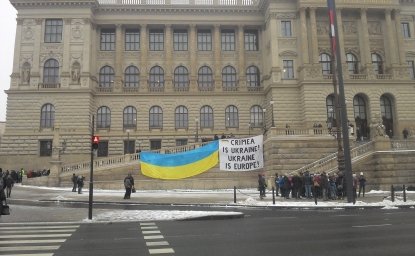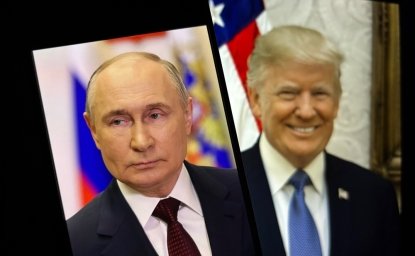The Ukrainian Man-Made Famine of 1932-1933

On 13 November 2003 the Kennan Institute, the Embassy of Ukraine to the United States, the Ukrainian Congress Committee of America, and the U.S.-Ukraine Foundation convened a conference to examine new data about the Ukrainian famine; the international reaction (and non-reaction) to the famine; and how the famine fits within our understanding of genocide. "Each year, we learn more and more about the famine in Ukraine. Even so, it is still difficult to grasp the enormity of the tragedy: millions of people, in what was the breadbasket of the then-Soviet Union, were quite literally starved to death," stated keynote speaker Paula Dobriansky, Undersecretary for Global Affairs, U.S. Department of State.
Historians have long known that the Soviet Union exported grain harvested in Ukraine and other agricultural centers during Joseph Stalin's forced collectivization of agriculture in the early 1930s in order to finance the rapid industrialization of the Soviet Union. New evidence from Russian and Ukrainian archives now shows that it was the intent of Stalin and his lieutenants to use starvation as a weapon against perceived potential enemies.
According to Yuri Shapoval of the Institute of Political and Ethnonational Studies in Kyiv, Stalin desired to turn Ukraine into a "model Soviet Republic," but feared that the Ukrainian Communist Party was penetrated by Polish agents and believed that "nationalist tendencies" in the Ukrainian peasantry guaranteed their disloyalty to the Soviet state. Soviet officials used this perception of disloyalty to justify the "special measures" used in Ukraine. Failure to meet a grain quota was met with "in-kind fines" (the confiscation of all food from a farm or village). James Mace of University of Kyiv-Mohyla Academy maintained that the state-organized mass killing of the rural population combined with the attempted destruction of Ukrainian culture amounted to genocide against the Ukrainian nation. He noted that blockades were imposed to keep food from going in to Ukraine, and to keep starving Ukrainians inside. At the same time, leading elements of Ukrainian society, from teachers to artists, were imprisoned or killed.
Abbott Gleason of Brown University agreed that new evidence demonstrated that Ukraine was singled out as a target of Stalin's ire. He cautioned that the strictest interpretation of genocide—the intention to exterminate the entire population—does not seem to fit with Stalin's desire to mold Ukraine into a "model Soviet Republic." Mace and Shapoval responded by pointing out that a famine in the Russian Volga region was met with government assistance, and residents were allowed to escape to Siberia, whereas the North Caucasus, an area with a substantial Ukrainian population, was targeted with many of the same special measures used in Ukraine. Stalin's plan for Ukraine as a "model Soviet Republic" envisioned the destruction of Ukrainian culture and the deaths of all who would cling to that culture, concluded Mace.
The second panel wrestled with the issue of international reaction to the famine in Ukraine at the time. Panelists Eugene Fishel of the Department of State and independent scholar Leonard Leshuk both agreed that there were accurate news accounts of the famine provided by Britsh journalists such as Malcolm Muggeridge and Garrett Jones. They were largely drowned out by positive media coverage of the Soviet Union by journalists seeking to curry favor with the Soviet government. The most famous example of such reporting came from Walter Duranty of The New York Times, who denied the famine and won a Pulitzer Prize in 1932 for his reporting on the Soviet Union. The U.S. government, and other governments, viewed the famine as a strictly internal matter that did not have a direct impact on national interests. Moreover, the U.S. government did not wish to derail negotiations to open diplomatic relations, as the Soviet Union was seen in the midst of the Great Depression as a potentially important market for U.S. industrial goods.
The final panel attempted to put the Ukrainian famine in the broader context of genocides throughout history. Frank Chalk of Concordia University, Montreal noted that hunger had been used throughout history as a weapon against populations—from the Romans salting the fields of Carthage to colonial powers burning local crops to weaken and suppress revolts. David Marcus of Lieff, Cabraser, Heimann and Bernstein, LLP described how man-made famine does not fall into an existing framework under international law, which recognizes genocide, war crimes, and crimes against humanity. He recommended codifying famine law to criminalize inflicting or creating conditions for famine.
Gregory Stanton of Genocide Watch noted that it was not until 1944 that the term genocide was introduced by Raphael Lemkin, and not until the 1948 Geneva Conventions that it was outlawed. Yet "since 1948, there have been at least fifty-five genocides and political mass-murders…with more than eighty million victims," stated Stanton. "The prevention and prosecution of genocide has been plagued by ‘definitionalism.'
Author


Kennan Institute
The Kennan Institute is the premier US center for advanced research on Eurasia and the oldest and largest regional program at the Woodrow Wilson International Center for Scholars. The Kennan Institute is committed to improving American understanding of Russia, Ukraine, Central Asia, the South Caucasus, and the surrounding region through research and exchange. Read more

Explore More
Browse Insights & Analysis
The OSCE is a Good Value for America

Infographic | Russia's Illegal Annexation of Crimea

Russia’s Indigenous Communities and the War in Ukraine
